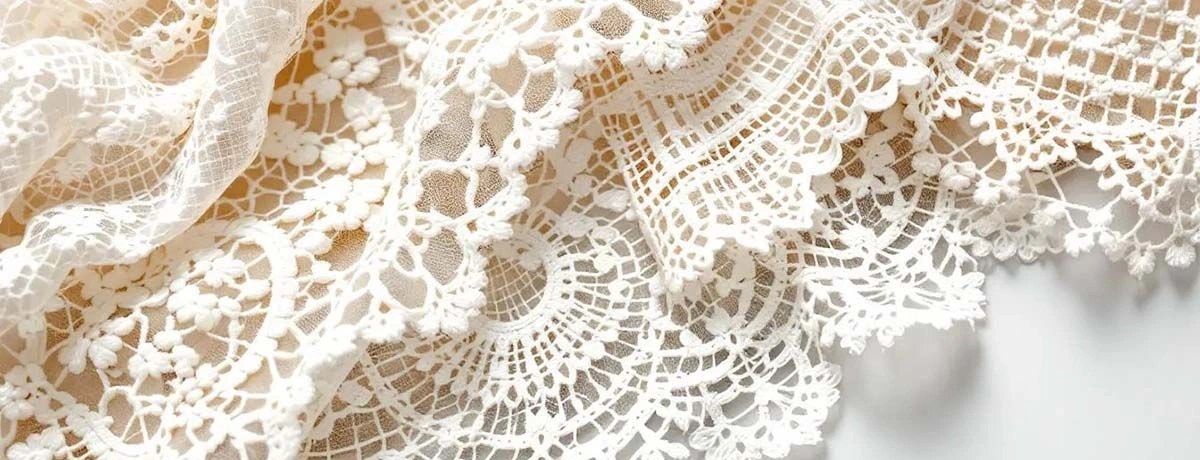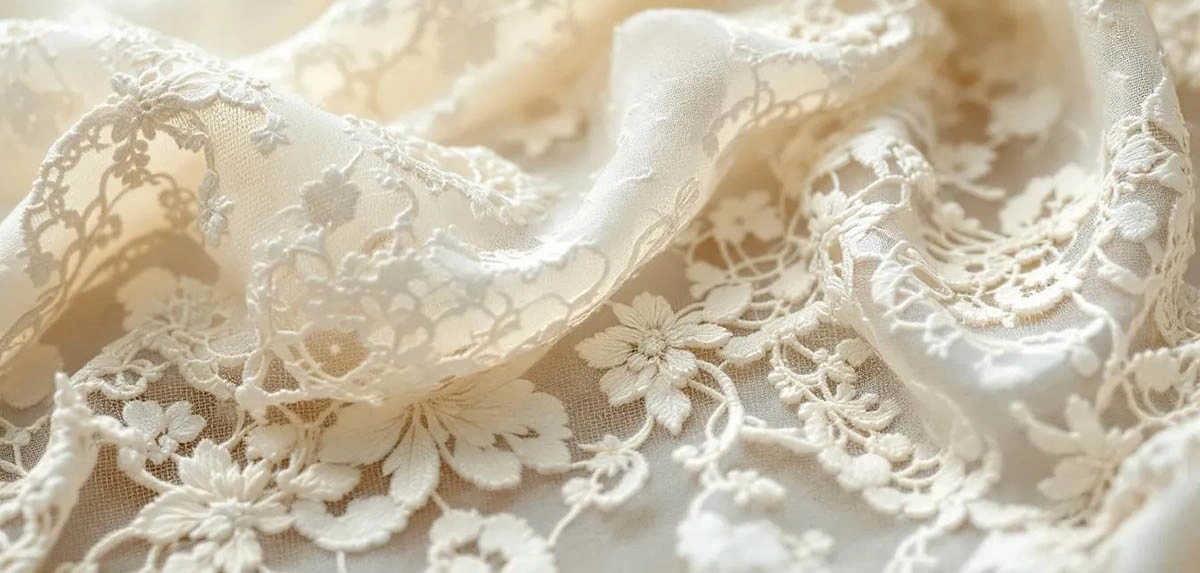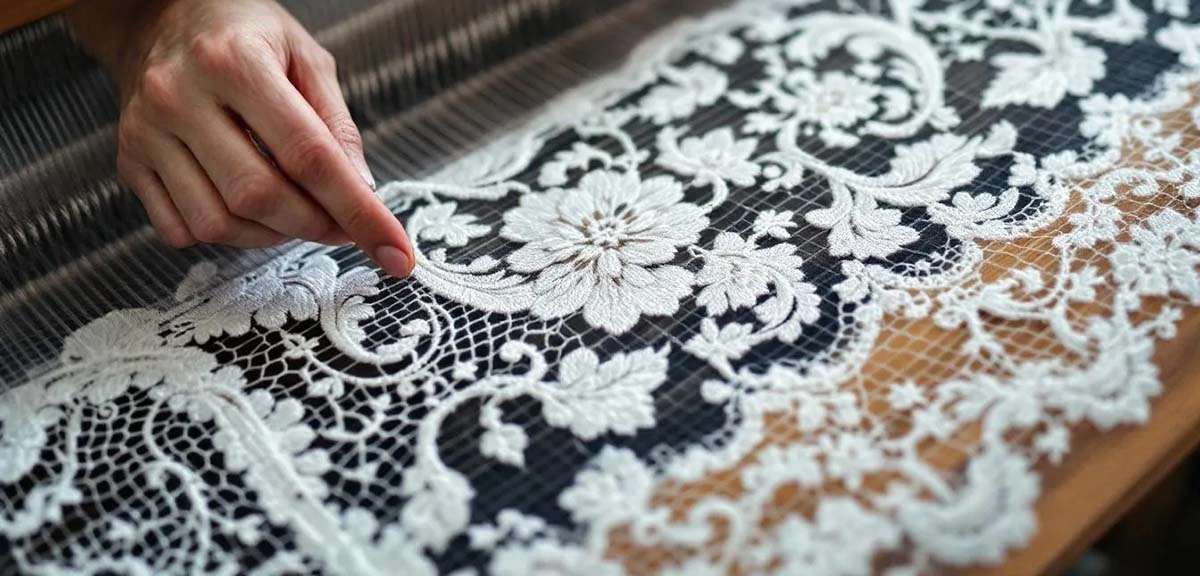Mastering Lacing Fabric: Types, Techniques, and Uses

Lacing fabric is the process of creating intricate patterns with threads, resulting in beautiful and delicate designs. In this article, we will explore the types, techniques, and applications of lacing fabric in both fashion and home decor.
Key Takeaways
-
Lacing fabric is an intricate textile art form that has evolved over centuries, commonly used in fashion and home decor for its elegance and versatility.
-
Key techniques for making lace include bobbin lace, needle lace, and chemical lace, each offering unique patterns and textures that require different skill sets.
-
Lace fabric comes in various types such as French, knitted, and crocheted lace, utilized across fashion, decor, and crafts, with a growing emphasis on sustainable materials and practices in production.
What is lacing fabric?

Lacing fabric refers to the process of creating intricate patterns and designs using various threads. This art form has been cherished for centuries, with different techniques producing unique textures and patterns that add elegance and sophistication to garments and home decor items. The delicate, open texture of lace fabric is what makes it so captivating, whether it’s featured in a wedding dress, lingerie, or high-fashion garment.
Today, lace fabric continues to be a symbol of refinement and luxury, prominently featured in bridal gowns, evening wear, and high-fashion collections. The meticulous craftsmanship involved in lace making commands respect and admiration, making each piece a work of art in its own right.
Lacing fabric in modern times
In modern times, lace fabric has maintained its status as a symbol of elegance and refinement, prominently featured in wedding dresses and high-fashion garments. French lace, knitted lace, and crocheted lace are among the most popular types, each appreciated for its unique texture and aesthetic appeal. These lace fabrics are not only used in fashion but also in home decor items like curtains and tablecloths, adding a touch of sophistication to any setting.
Historically, lace fabric has evolved significantly from its origins, becoming a staple in fashion, particularly during the Renaissance and continuing into modern times. Today, it is extensively used in women’s fashion, including lingerie and sophisticated attire, as well as in home decor for items like curtains and tablecloths. The versatility and timeless appeal of lace fabric ensure that it remains a beloved material in various applications.
Techniques for making lacing fabric

Creating lace fabric involves several techniques, each offering unique textures and patterns. The most common methods include:
-
Bobbin lace
-
Needle lace
-
Chemical lace Each technique has its own set of intricacies and requires a different skill set, making lace making a diverse and fascinating craft.
Bobbin lace is created by intertwining threads wound on bobbins, with the complexity determined by the number of threads used. Needle lace, on the other hand, is made with a needle and thread and is known for its intricate designs and high cost due to the time-consuming nature of the process.
Chemical lace is a more modern technique that involves creating designs on a temporary fabric that is dissolved away, leaving only the lace pattern behind.
Bobbin lace technique
Bobbin lace is a traditional technique that involves intertwining threads wound on bobbins to create intricate patterns. The complexity and beauty of the lace are determined by the number of threads used, allowing for a wide range of designs from simple to highly elaborate.
This method requires precision and skill, making bobbin lace a cherished craft among lace makers.
Needle lace technique
Needle lace is considered the pinnacle of lace making due to its intricate designs and the time-consuming nature of the process. Made with a needle and thread, this technique allows for highly detailed and delicate patterns that are often more expensive due to the labor involved.
Needle lace is a testament to the skill and patience of the lace maker, resulting in exquisite laced finished piece that are highly valued in the world of needlework.
Chemical lace technique
Chemical lace involves creating designs on a temporary fabric that is later dissolved away, leaving only the intricate lace pattern behind. This modern technique has evolved to use heat or water instead of chemicals to remove the fabric, providing a more environmentally friendly option.
While generally considered lower in quality than traditional bobbin and needle lace, chemical lace allows for the mass production of lace patterns at a lower cost.
Popular types of lacing fabric

Lace fabric comes in numerous varieties, each with unique features and cultural origins. Among the most popular types are:
-
French lace
-
Knitted lace
-
Crocheted lace These types are known for their intricate patterns and luxurious appearance. These lace fabrics have developed over time, reflecting diverse techniques and cultural influences.
Different types of lace include:
-
French lace: renowned for its rich texture and elaborate designs, often used in wedding dresses and high-fashion garments.
-
Knitted lace: known for its elasticity and intricate patterns.
-
Crocheted lace: characterized by its textured and open weave.
Each type of lace fabric brings its own charm and elegance to many different types of applications, making them a prime example of what is highly sought after in the textile industry.
French lace
French lace is celebrated for its rich texture and elaborate designs, making it a popular choice for wedding dresses and high-fashion garments. This type of lace is known for its luxurious appearance and intricate patterns, often featuring delicate floral motifs and sometimes enhanced with beads or embroidery.
French lace adds a touch of elegance and sophistication to any framed garment or decor item adorned with flowers and laces.
Knitted lace
Knitted lace is an elastic lace with many small holes, primarily used for shawls and table covers. This type of lace is unique because it cannot be made with machines, emphasizing its intricate woven handmade appeal.
The patterns in knitted lace are formed by yarn overs and decreases, creating beautiful and delicate designs that are highly valued for their craftsmanship.
Crocheted lace
Crocheted lace is characterized by its textured and open weave, commonly created with a crochet hook and yarn. This type of lace allows for lightness and intricate patterns, contributing to its decorative appeal. Popular styles of crocheted lace include filet crochet, pineapple crochet, and Irish crochet, each offering unique textures and designs that enhance the beauty of various items.
Applications of lacing fabric
Lace fabric is incredibly versatile, finding applications in fashion, home decor, and craft projects. Its delicate and intricate patterns add a touch of elegance and sophistication to a wide range of items. From evening gowns and bridal wear to throw pillows and tablecloths, lace fabric enhances the aesthetic appeal of various products, making them more luxurious and refined.
In addition to its decorative role, lace fabric is also used for functional purposes, such as enhancing the durability and comfort of garments. The open fabric of lace allows for breathability, making it a popular choice for lingerie and other intimate apparel.
Lace fabric is also widely used in arts and crafts, where its intricate designs can be incorporated into various creative projects involving sewing lace and stretch lace.
Fashion and accessories
Lace fabric holds a significant place in fashion, particularly in bridal gowns and lingerie. Its luxurious and intricate patterns command attention and symbolize sophistication and elegance. Lace is commonly used in:
-
Bridal dresses
-
Lingerie
-
Women’s garments
-
Gloves
-
Socks
-
Sweaters
The soft and shiny appearance of silk lace, in particular, commands attention and enhances the elegance of these metallic garments, making them more appealing and luxurious. These details contribute to the overall luxurious feel of silver gold.
Home decor items
Lace fabric enhances the aesthetic appeal of home decor items such as doilies, throw pillow, blankets, and tablecloths. It is commonly used to embellish curtains, adding a light, airy quality to the room. Lace is also used in creating decorative bed linens, lampshades, and wall hangings, adding a touch of sophistication and elegance to home furnishings.
Craft projects
Lace fabric is widely used in arts and crafts, contributing to its popularity in making decorative pieces and accessories. Craft projects can include items like lace embellishments for clothing, decorative borders for home decor, and intricate handmade accessories.
Proper care, such as laying lace flat to dry after washing, is essential to maintaining the integrity of lace in these projects.
Materials used in lacing fabric

Lace fabric can be made from a variety of materials, each offering different textures and qualities. Natural fibers such as cotton, silk, and linen are traditionally used in lace making, providing strength, durability, and a luxurious feel. These materials are often chosen for their ability to create intricate and delicate patterns, enhancing the overall quality of the lace.
In addition to natural fibers, synthetic fibers like polyester and rayon are also commonly used in lace production. These materials offer a cost-effective alternative that is easy to maintain and can mimic the appearance of natural fibers while being more resistant to wear and tear. Modern lace fabrics often combine various fibers to enhance durability and aesthetic appeal.
Linen threads
Linen threads, derived from the flax plant, are favored for their strength and durability, making them ideal for high-quality lace. These threads have the ability to create intricately detailed lace, enhancing the overall quality of the fabric.
Linen threads also offer a natural, rustic charm that adds a unique texture to lace fabric, making it a popular choice for both fashion and home decor items.
Silk threads
Silk threads are known for their luxurious texture, making them a popular choice for high-end lace fabric. The smooth finish of silk threads contributes to the overall aesthetic of the fabric, enhancing its appeal in fashion.
Due to their luxurious qualities, silk threads and silver thread are often utilized in bridal and evening wear, ensuring a premium finish that emphasizes the intricate designs and patterns associated with elegant fashion.
Synthetic fibers
Synthetic fibers such as polyester and rayon are commonly utilized in lace making. These fibers offer a cost-effective alternative that is also easy to maintain.
Synthetic fibers can mimic the appearance of natural materials while being more resistant to wear and tear, making them a practical choice for everyday fashion and decor. Their widespread use in lace production ensures that beautiful and intricate designs are accessible to a broader audience.
Environmental impact of lacing fabric
The ecological effects of lace production differ greatly depending on the fabric type used. The lace industry significantly contributes to pollution through the use of synthetic fibers, chemicals, and excessive resource consumption. However, the environmental impact can be mitigated by choosing sustainable materials and adopting eco-friendly practices in lace manufacturing.
For instance, using organic materials and eco-friendly dyes in lace production can significantly reduce environmental harm. Certifications like OEKO-TEX and GRS help ensure that lace fabrics are produced in a sustainable and responsible manner, promoting the use of recycled materials and reducing the overall environmental footprint.
Eco-friendly materials
The environmental impact of various fabrics includes:
-
Synthetic lace fabrics contribute to plastic and toxic chemical pollution.
-
The sustainability of cotton and linen production varies based on agricultural practices, making it essential to assess their methods.
-
Silk production is regarded as highly environmentally sustainable compared to synthetic alternatives.
Choosing eco-friendly materials and adhering to certifications like OEKO-TEX can ensure that lace fabrics are safe for skin contact and environmentally friendly.
Sustainable practices
Adopting sustainable practices in lace production is crucial for minimizing environmental impact. These practices include:
-
Using organic materials
-
Using eco-friendly dyes
-
Obtaining certifications like the Global Recycled Standard (GRS), which emphasize recycling and environmentally friendly practices in textile production
These measures ensure that lace fabrics are produced responsibly and sustainably.
Certifications for lacing fabric
Certifications for lacing fabric, such as OEKO-TEX and GRS, play a crucial role in ensuring the quality and safety of lace fabrics. These certifications indicate that the fabric is free from harmful substances and is produced in an environmentally friendly manner. They help consumers make informed choices and promote sustainable practices in the textile industry.
OEKO-TEX certification ensures that lace fabric is tested and confirmed to be free from harmful chemicals, promoting safety for skin contact.
The Global Recycled Standard (GRS) certifies that grey lace fabric contains recycled materials and meets strict social and environmental criteria, ensuring that it is produced responsibly and safely.
OEKO TEX certification
OEKO TEX certification plays a vital role in ensuring the quality and sustainability of lace fabric. This certification indicates that the fabric is free from harmful substances and is safe for human use. By promoting safety and sustainability, OEKO TEX certification helps consumers make informed choices and supports environmentally friendly practices in the textile industry.
GRS certification
The Global Recycled Standard (GRS) verifies that lace fabrics are made from recycled materials and adhere to strict social and environmental standards. This certification ensures that lace fabric meets important criteria for responsible and safe production, promoting recycling and environmentally friendly practices in the textile industry.
Where to buy lacing fabric
Lacing fabric can be purchased from various sources:
-
By the yard or in bulk from various online retailers.
-
Specialized suppliers and e-commerce platforms that offer extensive selections of lace fabrics, accommodating various styles and budgets.
-
Wholesalers, which can provide cost advantages for larger projects, making it an attractive option for both individuals and businesses.
American factories produce lace fabric in small quantities, while countries like China and France are major producers in the textile industry. Notable suppliers like MH Embroidery Lace Fabric cover research, design, production, and sales of exquisite embroidery lace products, offering wholesale options for those looking to purchase in bulk.
Wholesale suppliers
MH Embroidery Lace Fabric is a prominent player in the lacing fabric industry, offering wholesale options for those looking to buy in bulk. This comprehensive enterprise covers research and development, design, production, and sales of exquisite embroidered lace products, ensuring high-quality lace fabric for various applications.
Online marketplaces
E-commerce platforms like Amazon and Etsy provide extensive selections of lace fabrics, accommodating various styles and budgets. Notable suppliers like Royal Lace and Fabric Wholesale Direct offer bulk lace fabrics at competitive stock prices.
These online marketplaces make it easy to search for the perfect lace fabric for any project, whether you’re looking for something luxurious or cost-effective.
Caring for lacing fabric
To maintain lace fabric, follow these care instructions:
-
Handle it gently and avoid traditional washing methods that may cause damage.
-
Hand wash or use a gentle machine cycle to preserve the delicate structure of the lace.
-
After washing, lay the lace flat to dry to prevent stretching or distortion that can occur from hanging.
Proper storage is also crucial for maintaining the integrity of lace fabric. Store lace in a cool, dry place, folded neatly or rolled to prevent creases and damage. These care tips ensure that lace fabric remains in pristine condition and is ready for use in any fashion or decor project.
Washing and drying
Hand washing is the preferred method for preserving lace fabric, as it minimizes the risk of tearing or fraying. For drying, lace should be laid flat on a towel to absorb excess water instead of being twisted or wrung.
This gentle care routine helps maintain the delicate structure and appearance of lace fabric, ensuring its longevity.
Storing lacing fabric
Lace fabric should be stored in a cool, dry area to prevent deterioration. Neatly folding or rolling the lace helps avoid creases and damage, ensuring that the fabric remains in pristine condition.
Proper storage methods are essential for maintaining the secure quality of lace fabric over time, keeping it ready for use in various projects.
Summary
In summary, lace fabric is a timeless and versatile material that adds elegance and sophistication to fashion, home decor, and craft projects. From the intricate patterns of French lace to the practical appeal of synthetic fibers, lace fabric comes in various types, each with unique features and cultural significance. Whether used in bridal gowns, lingerie, or decorative items, lace fabric enhances the aesthetic appeal of various products.
Understanding the different techniques for making lace fabric, such as bobbin lace, needle lace, and chemical lace, helps appreciate the craftsmanship involved in creating these intricate designs. By choosing eco-friendly materials and adopting sustainable practices, we can enjoy the beauty of lace fabric while minimizing its environmental impact. With proper care and storage, lace fabric can remain in pristine condition, ready to add a touch of elegance to any project.
Frequently Asked Questions
What are the main types of lace fabric?
The main types of lace fabric are French lace, knitted lace, and crocheted lace, each distinguished by its unique texture and intricate patterns. Understanding these types can enhance your textile selections.
How should I care for lace fabric?
To ensure your lace fabric remains in excellent condition, hand wash or use a gentle machine cycle, then lay it flat to dry. Store it in a cool, dry place, folded neatly or rolled to avoid creasing.
Where can I buy high-quality lace fabric?
You can find high-quality lace fabric from specialized suppliers, online marketplaces like Amazon and Etsy, and wholesale suppliers such as MH Embroidery Lace Fabric. Exploring these options will help you secure the best materials for your needs.
What materials are commonly used in lace fabric?
Lace fabric is typically made from materials such as cotton, silk, linen, and synthetic fibers like polyester and rayon, providing various textures and qualities to suit different applications.
What certifications should I look for when buying lace fabric?
When purchasing lace fabric, prioritize certifications such as OEKO TEX and GRS to ensure it is free from harmful substances and produced sustainably. These certifications guarantee both safety and environmental responsibility.
Contact MH
MH offer lace fabrics. Please contact us for more details or inquiries. We're here to help!


